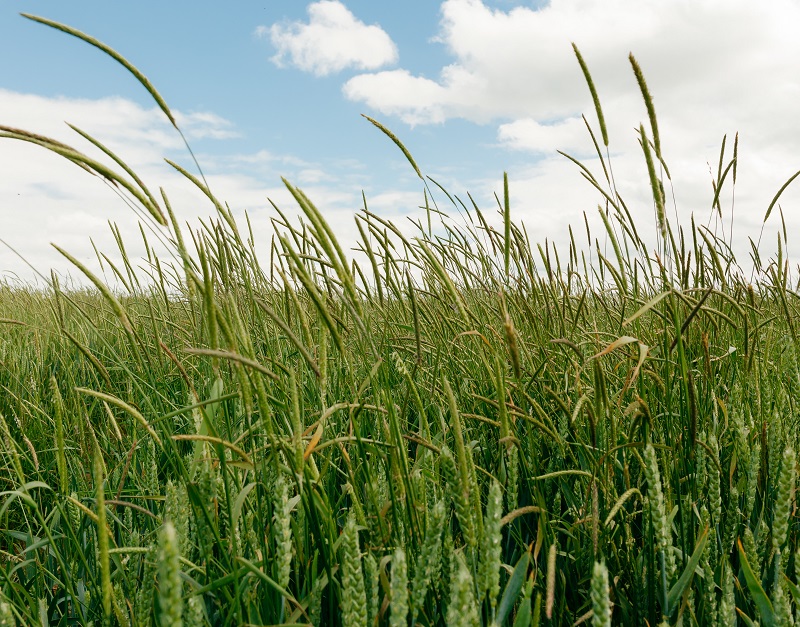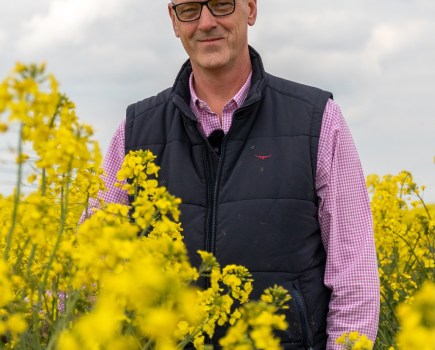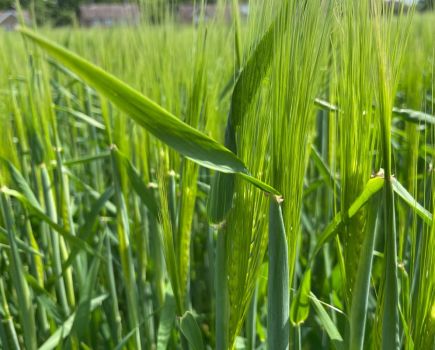The 2019/20 season will no doubt go on record as one of the most challenging for growers in recent times.
The persistent rainfall in the autumn forced a winter wheat area reduction in every single region of GB and nationally, a reduction of 20% down to 1.375 million ha, according to 2020 AgriInsight – Kynetec data. It’s a picture that shows just how difficult conditions became, particularly when you take into account 197 thousand hectares of that crop failed, putting the harvested area of winter wheat down 32% on harvest 2019.
It’s an autumn that won’t be forgotten and certainly one not to be repeated, however, with many growers scarred from the effects of last autumn, there’s been a growing concern that some could be tempted to drill earlier than normal, which could prove to be hugely detrimental from a weed control perspective, believes Stuart Sutherland, technical manager at Interagro. “Blackgrass could be one of the most worrying consequences of early drilling, and we know from years of trial and error that delaying autumn drilling for as long as possible is key. However, we also have to appreciate that many growers are still feeling the effects of last year.”
“Therefore, optimising the performance of residual herbicides is going to be more important than ever this season.”
In a favourable year, pre- and peri-emergence herbicides can deliver high levels of blackgrass control, but the 97% control required to keep on top of populations makes this very difficult to achieve, he adds. “Optimising herbicide contact with germinating weeds is a vital component of successful weed control, but when it comes to pre- and peri-emergence applications, it’s not as straightforward as you might think.”
“Residual herbicide performance depends on good application and soil conditions, with sufficient uptake in soil water by the roots and shoots of germinating weeds. Herbicide placement and positioning in the soil is therefore vital but several factors threaten success.”
These factors include poor coverage, too wet or too dry soils and heavy rainfall that could threaten crop safety. However, including an adjuvant within your programme could be the solution that many growers seek this autumn, says Stuart. “Interagro’s adjuvant Backrow has proven abilities to help residual herbicides to perform in suboptimal conditions, making it a vital addition pre- and peri-em to help mitigate the effects of poor application conditions, and very dry or very wet soils that lead to poor weed control and poor crop competition.”
“With double-digit increases in weed control on offer, Backrow could be extremely beneficial in winter crops this autumn.”
So how exactly does it work?
“By creating the perfect size spray droplets for pre- and peri-em herbicide applications to work at their best, Backrow reduces the number of fine spray droplets prone to drift and increases the number of droplets in the optimum size range for better spray coverage of the soil,” he explains.
“This improvement in coverage increases the number of weeds that come into contact with the herbicide at germination, resulting in a higher level of weed control overall.”
Backrow can also increase herbicide uptake in dry and wet soils, improving the overall level of weed control that can be achieved in suboptimal soil conditions, he adds. “The adjuvant helps to retain moisture in the top 5cm of the soil – in dry soils this higher moisture means more of the herbicide can be available for uptake into weeds.
“By increasing herbicide retention in the top 5cm of the soil, Backrow also improves herbicide uptake in very wet soils, instead of herbicides being washed below the weed germination zone where uptake would be prevented.”
Another beneficial effect of Backrow is its ability to protect crop safety in wet soils. “By minimising herbicide movement and keeping them in the top 5cm of the soil, Backrow can prevent chemistry moving down through the soil or in worst case scenario, leaching into groundwater.”
Agronomists outlook
North Lincs
As blackgrass continues to be a major concern for North Lincs based agronomist, Fred Fowler, a shift in drilling tactics could worsen the issue this year. “The concern among many is that no one wants a repeat of last year with farmers struggling to get any winter crops in the ground.
“We know that many growers will be choosing to drill earlier than usual to make sure crops are the ground, but from our point of view – and from a blackgrass perspective – we would rather it was delayed until the second or third week of Oct on high pressure grassweed sites.”
“That said, we do understand that this year in particular growers will need to go when they can, therefore, getting the most out of residual chemistry by using the adjuvant Backrow is going to be key, in my opinion.”
Fred says he was introduced to Interagro’s adjuvant, Backrow, as soon as he joined Agrii five years ago. “Since then, I’ve consistently seen the benefits through autumn and spring trials and most importantly, have seen a real improvement when it comes to blackgrass control – an average of 9% improvement, in fact.
“Backrow is fantastic at helping bind chemistry to the soil, ensuring the product stays in the top 5cm of soil where most weeds germinate, which in turn reduces crop damage through leaching, as well as reducing the risk of unwanted chemical in watercourses.”
Gloucs/Worcs
Covering the Gloucs, and Worcs, Agrii agronomist, John Vickery, also says blackgrass is by far the biggest weed issue facing growers.
To enhance the efficacy of residual chemistry and crop safety, in a bid to reduce blackgrass burdens, John has been advising the use of Interagro’s adjuvant, Backrow.
“One of the main things I’ve found with Backrow is that it really does push chemical efficacy just that bit further. It also helps products adhere to the soil better, which is incredibly beneficial in times of heavy rainfall as it builds in a little more crop safety when large herbicide stacks are applied.”
With the addition of Backrow, John has also found it’s possible to reduce water rates, without compromising on performance. “Our work has shown that when applying residual herbicides, using water rates of 200 l/ha tends to give better weed control than 100 l/ha. However with the addition of Backrow operators can use 100 l/ha, without an efficacy compromise, ensuring maximum spraying output at a critical period.”
Midlands
For Midlands based Agrii agronomist, Peter Carr, it’s a mixed bag when it comes to weed control on his patch. “We face lots of different challenges here with a wide range of soil types from heavy clays to sand, and everything in the middle.
“Blackgrass is undoubtedly key, but weeds such as bur chervil are becoming more of a challenge and we’re seeing an increasing amount of brome bubbling away in the background.”
With a whole host of weed challenges to overcome, anything that can reduce pressure and promote better control is a welcome aid, and on the blackgrass front, Peter says Interagro’s adjuvant Backrow can help squeeze that little bit extra from chemistry.
“Agrii has been trialling Backrow for a number of years, using it within stacks of chemistry to try to dig into that extra percentage of control against blackgrass.
“The benefits were seen right from the off, and in our trials, we have been able to glean an extra 9% of control when the adjuvant was used – it almost felt too good to be true.”
According to Peter, the effects of Backrow are best seen in challenging conditions – when seedbeds are not as good – or on lighter soils. “Generally speaking, we recommend using Backrow with all pre-em chemistry, but particularly on light ground, as it really helps to keep products at the top.”
Hants
In Hants, while blackgrass burdens don’t appear to be as detrimental as those seen in eastern counties, there’s a certainly a conscious effort being made to keep a lid on things – by both growers and agronomists, says Agrii agronomist, Mark Glover.
“While there are a few farms with high blackgrass populations, as a rule I would say it is nowhere near as severe as in the eastern counties. However, we certainly want to keep it that way.”
In a bid to keep on top of the issue, Mark recommends the use of Interagro’s adjuvant, Backrow, with both pre- and peri-emergence herbicides. “Pretty much 100% of my growers use it to both optimise chemical performance and promote crop safety. From a blackgrass point of few, there’s a strong backlog of evidence to show that it really can help push that extra control, so there’s definitely a case for using it this autumn.”
Backrow application technology trials at Agrii
David Felce, regional technical advisor at Agrii explains in this short video, how Backrow has been put through its paces in farm trials, and some of the results that have been achieved.
In Agrii trials over the past 11 years (2009 to 2020), Backrow has improved the control of various grass-weeds by an average of 9.5% – this is the mean of 46 comparisons either pre- or peri-em, and with a range of residual herbicides applied in cereals. “The highest increases in weed control will be achieved in suboptimal conditions,” says Stuart Sutherland.
For more info on Backrow, visit: https://bit.ly/2FCyNSl




